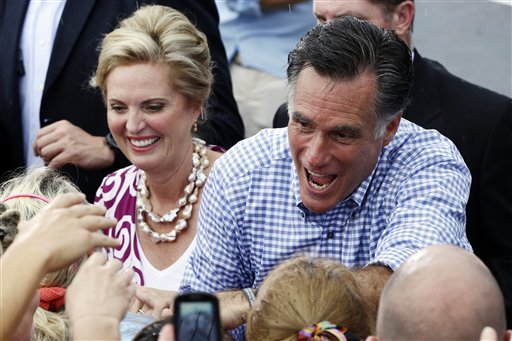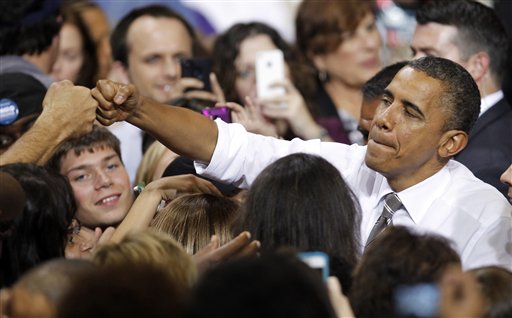WASHINGTON — Mitt Romney’s campaign is working hard to chip away at President Barack Obama’s advantage among early voters, and there are signs the effort is paying off in North Carolina and Florida, two competitive states that the Republican nominee can ill afford to lose. Obama is doing better in Iowa, another battleground state important to both candidates.
Obama dominated early voting in key states four years ago, giving him a big advantage over Republican John McCain before Election Day even arrived. In Colorado, Florida, Iowa and North Carolina, Obama built up such big leads among early voters that he won each state despite losing the Election Day vote, according to voting data compiled by The Associated Press.
Romney’s campaign won’t predict victory among early voters this year. But a top campaign official is adamant that Romney will not let Obama build insurmountable leads among early voters in key states.
“They’re not going to run up the same margins as they did four years ago,” said Rich Beeson, political director for the Romney campaign. “It just isn’t going to happen.”
Early voting for the presidential election has started in more than 30 states — much of it by mail, though some in person — and some important numbers are starting to dribble in. No votes will be counted until Nov. 6. However, North Carolina, Florida and Iowa report the party affiliation of people who have cast ballots. Other states will follow.
Among the 29,400 voters who have cast absentee ballots in North Carolina, 54 percent are registered Republicans and 28 percent are Democrats, according to the United States Elections Project at George Mason University.
It’s a small sample — more than 2.6 million people voted before Election Day in North Carolina in 2008. And these are all mail ballots, which have historically favored Republicans; in-person voting starts Oct. 18 in North Carolina. Nevertheless, Republicans are encouraged because McCain lost the state’s early vote by 11 percentage points.
“North Carolina was a place that they totally caught us flat-footed in 2008,” Beeson said. “They jumped out to a lead and never looked back. You don’t see that happening this time — Republicans have the lead.”
Florida’s sample is even smaller — only 14,500 votes so far — but it too favors Republicans over Democrats, 53 percent to 32 percent. In 2008, nearly 4.6 million voters in Florida cast ballots before Election Day.
Democrats have a big lead in Iowa — as they did in the past two presidential elections. About 60 percent of the 127,100 voters who have cast absentee ballots so far were registered Democrats. Twenty-two percent were Republicans and 18 percent were unaffiliated, according to the United States Elections Project.
In Ohio, a perennial battleground state, Democrats have an edge over Republicans among people who have requested absentee ballots, though relatively few completed ballots have been submitted. Among the 691,000 people who have requested absentee ballots in 49 of the state’s 88 counties, 30 percent are Democrats and 24 percent are Republicans. Forty-six percent are unaffiliated voters, according to data collected by the AP.
It’s still early — even for early voters — so these numbers could change significantly before Election Day. And voters can always cross party lines when they vote for any office. Still, both campaigns will follow the numbers closely as November approaches, using them to gauge their success in getting early voters to the polls.
The stakes are high. About 35 percent of voters are expected to cast ballots before Election Day, either by mail or in person, a small increase over four years ago, according to Michael McDonald, an early voting expert at George Mason University. McDonald tallies voting statistics for the United States Elections Project.
“Most of the early vote doesn’t happen until the last week of the election,” McDonald said. “While there are some people voting now, of course, people who are undecided aren’t going to cast their vote until they’re certain of their vote and they’re certain who they’re going to vote for in the down-ballot races as well.”
The Obama campaign’s strategy is to bank as many votes as possible before Election Day, freeing up campaign workers on Nov. 6 to focus on a smaller number of potential supporters, making sure they get to the polls. It is a strategy that worked well in 2008, when the campaign compiled massive amounts of information about voters in every state.
Since then, Obama’s political organization and his re-election campaign have been building on the work they did in 2008 in an attempt to reach even more potential early voters.
Asked about Romney’s operation, Jeremy Bird, the Obama campaign’s field director, said: “Are they better than John McCain? Sure.” But he added: “Are we better than Barack Obama in 2008? Absolutely.”
The Romney campaign’s strategy is to target supporters who don’t necessarily vote in every election, putting a premium on getting these voters to cast early ballots, Beeson said. If the campaign is successful, most of Romney’s remaining supporters would be people who are much more likely to vote, regardless of whether they are contacted by the campaign.
McCain employed a similar strategy in 2008 and it failed miserably. Beeson, however, said Romney’s campaign has far more resources than McCain’s campaign. And, he said, Republican voters are much more energized than they were in 2008.
“Democrats had a huge intensity factor and a huge funding advantage,” Beeson said. This year, he said: “The intensity gap is in our favor. Candidate Obama has now become President Obama, and you can only run on hope and change once.”
Send questions/comments to the editors.




Comments are no longer available on this story